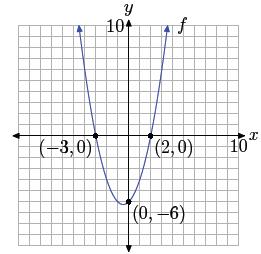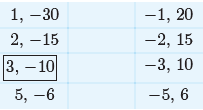Zeros of the Quadratic
![]() Example 4. Factor 3x2 + 34x − 24.
Example 4. Factor 3x2 + 34x − 24.
Compare
3x2 + 34x − 24 and ax2 + bx + c
and note that a = 3, b = 34 and c = −24. List all integer pairs whose product
equals
ac = (3)(−24) = −72.

We’ve framed the pair whose sum is the same as b = 34, the
coefficient of x in
3x2 + 34x − 24. Again, possible shortcuts are possible. If you can “think” of a
pair
whose product is ac = −72 and whose sum is b = 34, then it is not necessary to
list
any integer pairs. Alternatively, if you come across the needed pair as you are
listing
them, then you can halt the process. There is no need to
list the remaining pairs if you
have the one you need.
Use the framed pair to express the middle term as a sum, then factor by
grouping.
3x2 + 34x − 24 = 3x2 − 2x + 36x − 24
= x(3x − 2) + 12(3x − 2)
= (x + 12)(3x − 2)
We leave it to the reader to check this result.
Intercepts
The points where the graph of a function crosses the x-axis are called the
x-intercepts
of graph of the function. Consider the graph of the quadratic function f in
Figure 1.

Figure 1. The x- and y-intercepts
are key features of any graph.
Note that the graph of the f crosses the x-axis at (−3, 0) and (2, 0). These are
the
x-intercepts of the parabola. Note that the y-coordinate of each x-intercept is
zero.
In function notation, the solutions of f(x) = 0 (note the similarity to y = 0)
are
the x-coordinates of the points where the graph of f crosses the x-axis.
Analyzing the
graph of f in Figure 1, we see that both −3 and 2 are solutions of f(x) = 0.
Thus, the process for finding the x-intercepts is clear.
| Finding x-intercepts. To find the x-intercepts of
the graph of any function, set y = 0 and solve for x. Alternatively, if function notation is used, set f(x) = 0 and solve for x. |
Let’s look at an example.
![]() Example 5. Find the x-intercepts of the graph of the
quadratic function defined
Example 5. Find the x-intercepts of the graph of the
quadratic function defined
by y = x2 + 2x − 48.
To find the x-intercepts, first set y = 0.
0 = x2 + 2x − 48
Next, factor the trinomial on the right. Note that the coefficient of x2 is 1.
We need
only think of two integers whose product equals the constant term −48 and whose
sum
equals the coefficient of x, namely 2. The numbers 8 and −6 come to mind, so the
trinomial factors as follows (readers should check this result).
0 = (x + 8)(x − 6)
To complete the solution, we need to use an important property of the real
numbers
called the zero product property.
| Zero Product Property. If a and b are any real
numbers such that ab = 0, then either a = 0 or b = 0. |
In our case, we have 0 = (x + 8)(x − 6). Therefore, it
must be the case that either
x + 8 = 0 or x − 6 = 0.
These equations can be solved independently to produce
x = −8 or x = 6.
Thus, the x-intercepts of the graph of y = x2+2x−48 are located at (−8, 0) and
(6, 0).
Let’s look at another example.
![]() Example 6. Find the x-intercepts of the graph of the quadratic function f(x) =
Example 6. Find the x-intercepts of the graph of the quadratic function f(x) =
2x2 − 7x − 15.
To find the x-intercepts of the graph of the quadratic function f, we begin by
setting
f(x) = 0.
Of course, f(x) = 2x2 − 7x − 15, so we can substitute to obtain
2x2 − 7x − 15 = 0.
We will now use the ac-test to factor the trinomial on the left. Note that ac =
(2)(−15) = −30. List the integer pairs whose products equal −30.

Note that the framed pair sum to the coefficient of x in
2x2 − 7x − 15. Use the
framed pair to express the middle term as a sum, then factor by grouping.
2x2 − 7x − 15 = 0
2x2 + 3x − 10x − 15 = 0
x(2x + 3) − 5(2x + 3) = 0
(x − 5)(2x + 3) = 0
Now we can use the zero product property. Either
x − 5 = 0 or 2x + 3 = 0.
Each of these can be solved independently to obtain
x = 5 or x = −3/2.
Thus, the x-intercepts of the graph of the quadratic function f(x) = 2x2 −7x−15
are
located at (−3/2, 0) and (5, 0).
One more definition is in order.
| Definition 7. Zeros of a Function. The solutions of f(x) = 0 are called the zeros of the function f. |
Thus, in the last example, both −3/2 and 5 are zeros of the quadratic function
f(x) = 2x2−7x−15. Note the intimate relationship between the zeros of the
quadratic
function and the x-intercepts of the graph. Note that −3/2 is a zero and (−3/2,
0) is
an x-intercept. Similarly, 5 is a zero and (5, 0) is an x-intercept.
The graphing calculator can be used to find the zeros of a function.
![]() Example 8. Use the graphing calculator to find the zeros of the function f(x)
=
Example 8. Use the graphing calculator to find the zeros of the function f(x)
=
2x2 − 7x − 15.
Enter the function f(x) = 2x2 − 7x − 15 into Y1 in the Y= menu; then adjust the
window parameters as shown in Figure 2(b). Push the GRAPH button to produce the
parabola shown in Figure 2(c).
To find a zero of the function, proceed as follows:

Figure 2. Plotting the quadratic function f(x) = 2x2 − 7x
− 15.
• Press 2nd TRACE to open the CALCULATE window shown in Figure 3(a). From this
menu, select 2:zero.
• The calculator responds by asking for a “Left bound.” Use the arrow keys to
move
the cursor slightly to the left of the leftmost x-intercept, as shown in Figure
3(b).
Press the ENTER key.
• The calculator responds by asking for a “Right bound.” Use the arrow keys to
move
the cursor slightly to the right of the leftmost x-intercept, as shown in Figure
3(c).
Press the ENTER key.
• The calculator responds by asking for a “Guess.” You may use the arrow keys to
select a starting x-value any where between the left- and right-bounds you
selected
(note that the calculator marks these on the screen in Figure 3(d)). However,
the
cursor already lies between these marks, so we typically just hit ENTER at this
point.
We suggest you do so also.

Figure 3. Using the zero utility to find an x-intercept.
The calculator responds by marking the x-intercept and reporting its x-value at
the
bottom of the screen, as shown in Figure 4(a). This is one of the zeros of the
function.
Note that this value of −1.5 agrees nicely with our hand calculated result −3/2
in
Example 6. We followed precisely the same procedure outlined above to find the
second x-intercept shown in Figure 4(b). Note that it also agrees with the hand
calculated solution of Example 6.
In a similar vein, the point where the graph of a function crosses the y-axis is
called the y-intercept of the graph of the function. In Figure 1 the y-intercept
of the
parabola is (0,−6). Note that the x-coordinate of this y-intercept is zero.
Thus, the process for finding y-intercepts should be clear.

Figure 4. The zeros of f(x)−2x2 −7x−15.
| Finding y-intercepts. To find the y-intercepts of
the graph of any function, set x = 0 and solve for y. Alternatively, if function notation is used, simply evaluate f(0). |


